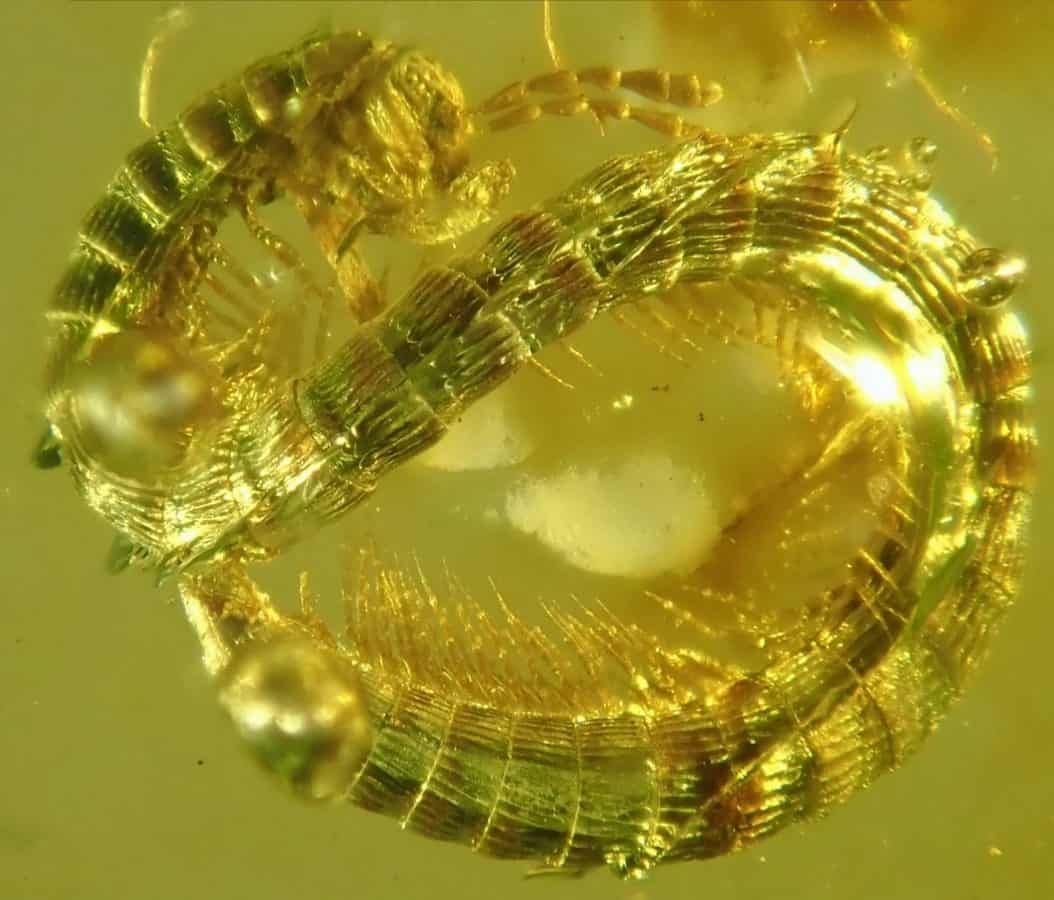
credit;SWNS
An extinct millipede that slithered beneath the legs of the dinosaurs 99 million years ago has been found trapped in amber in the Burmese jungle.
The ancient arthropod, whose name means ‘thousand feet’ in Latin, was so perfectly preserved it has been digitally reconstructed – in stunning detail.
It shows Earth was home to bizarre creatures large and small during the Cretaceous – from giant reptiles to tiny creepy crawlies.
The fossil, which is owned by a private collector, measures just 0.3 inches (8.2 mm) long and belongs to an entirely new sub order of millipedes known as Callipodida.
The body is so unusual it differs dramatically from any of it contemporary relatives, say scientists.
Tree resin from Myanmar, formerly Burma, has provided palaeontologists with a window into a lost world when tiny animal life was still evolving in the rainforests.
Powerful microscopes enaboled the international team to produce X rays of the specimen’s anatomy in 3D – information that would normally have disappeared in the mists of time.
Lead author Professor Pavel Stoev, of the National Museum of Natural History, Sofia, Bulgaria, said: “We were so lucky to find this specimen so well preserved in amber!
“With the next-generation micro-computer tomography (micro-CT) and the associated image rendering and processing software, we are now able to reconstruct the whole animal and observe the tiniest morphological traits which are rarely preserved in fossils.
“This makes us confident that we have successfully compared its morphology with those of the extant (living) millipedes.
“It came as a great surprise to us this animal cannot be placed in the current millipede classification
“Even though their general appearance have remained unchanged in the last 100 million years, as our planet underwent dramatic changes several times in this period, some morphological traits in Callipodida lineage have evolved significantly.”
The identification of the millipede suggesting this millipede group evolved at least some 100 million years ago.
Remarkably, it was unearthed with as many as 529 individual millipedes at a mine in north Myanmar’s Hukawng Valley – yet was the sole representative of its order.
Consequently, it has been named Burmanopetalum inexpectatum, Latin for “unexpected in Burma”.
Co author Dr Thomas Wesener, of the Alexander Koenic Zoological Research Museum, Bonn, Germany, said: “We are grateful to Patrick Muller, who let us study his private collection of animals found in Burmese amber and dated from the Age of Dinosaurs.
“His is the largest European and the third largest in the world collection of the kind. We had the opportunity to examine over 400 amber stones that contain millipedes.
“Many of them are now deposited at the Museum Koenig in Bonn, so that scientists from all over the world can study them.
“Additionally, in our paper, we provide a high-resolution computer-tomography images of the newly described millipede.
“They are made public through MorphBank, which means anyone can now freely access and re-use our data without even leaving the desk.”
Millipedes are relatives of centipedes and distant cousins of spiders and insects.
Dr Greg Edgecombe, an arthropod expert at the London Natural History Museum, said: “The entire Mesozoic Era – a span of 185 million years – has until now only been sampled for a dozen species of millipedes, but new findings from Burmese amber are rapidly changing the picture.
“In the past few years, nearly all of the 16 living orders of millipedes have been identified in this 99 million year-old amber.
“The beautiful anatomical data presented by Stoev et al. show Callipodida now join the club.”
To put Burmanopetalum inexpectatumit, described in ZooKeys, in perspective there have only been a handful of millipede suborders erected in the last 50 years.